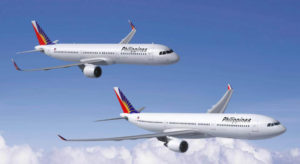 PAL Holdings, Inc. reported a bigger loss of P7.863 million in the first nine months of 2019 from the P3.287 million it lost in the same period last year as it recorded a hefty loss in the third quarter.
PAL Holdings, Inc. reported a bigger loss of P7.863 million in the first nine months of 2019 from the P3.287 million it lost in the same period last year as it recorded a hefty loss in the third quarter.
For the third quarter of 2019 alone, total comprehensive loss was P4.85 billion, 84.8% higher than the P2.63 billion loss logged in the same period last year, said PAL Holdings, Inc., parent company of flag carrier Philippine Airlines and sister airline PAL Express, in a regulatory disclosure.
Revenues for the third quarter was also slightly lower by 0.3% to P36.67 billion from P36.78 billion year-on-year due to the decrease in passenger and cargo revenues, offset by an increase in ancillary revenue.
For the period January to September 2019, PAL said revenues amounted to P117.92 billion, up 5.6% from the P111.62 billion posted in the same period last year.
PAL said the increase in revenue was mainly from passenger and ancillary revenues due to additional frequencies and new routes which boosted passenger volume. Passenger revenues grew 6% to P102.664 billion from P97.073 billion, while revenues from ancillary services rose 18% to P8.253 billion from P6.991 billion.
Growth, however, was partly offset by the decrease in cargo revenues, which declined by 7.9% to P6.899 billion from P7.487 billion.
Operating expenses went up 2.2% as maintenance cost increased by 8.8% and aircraft and traffic servicing expenses rose by 2.7%, driven by the growth in fleet, passenger and network operations. Reservation and sales likewise increased by 10.7% due to the growth in passenger volume.
Last month the flag carrier said it is embarking on a digital transformation as a strategy to reduce costs and return to profit. PAL said the next few months will be crucial as the new management introduces major changes to the 78-year-old airline’s business strategy.
PAL has been reporting a net loss since 2016. Last year, it announced a consolidated total comprehensive loss of P2.8 billion, 38.3% lower than its comprehensive loss of P4.6 billion in 2017.
PAL currently operates a fleet of 98 aircraft that includes six Airbus A350-900 and 10 Boeing 777-300ER wide-body jetliners for long-haul routes; 15 Airbus A330s for high-density Asia-Pacific, Australian and Middle Eastern routes; six A321neo longer-range versions; 24 A321 Classics; 19 A320s; and 10 De Havilland Dash-8-400s, in addition to classic versions of the Q300/400.
As of September 30, PAL has two additional aircraft scheduled for delivery before yearend.
